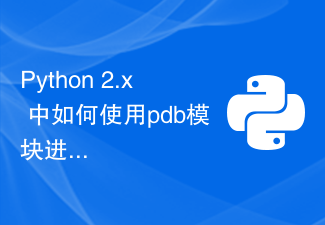With the continuous development and application of Go language, more and more engineers are beginning to use Go to develop various types of applications. In the development process, code optimization and debugging methods are a very important part. This article will share some commonly used methods and techniques in Go language development from two aspects: code optimization and debugging.
1. Code optimization of Go language
- Reduce memory allocation
In Go language, memory allocation is a time-consuming operation, so we The number of memory allocations should be minimized to improve program execution efficiency.
For example, avoid using functions such as append to add elements after the slice. An alternative is to pre-allocate enough capacity and then use subscripting to directly modify the slice elements, thus avoiding the memory allocation overhead.
- Using sync.Pool
sync.Pool is a memory pool provided by the Go standard library, which can be used to reuse some larger objects to avoid frequent creation and the overhead of destroying large objects.
For example, we can use sync.Pool to manage some larger objects, such as http.Request objects. In this way, before each call to the http.Handler.ServeHTTP method, we can obtain the http.Request object from sync.Pool and then pass it to the ServeHTTP method for processing. After processing, put the http.Request object back into sync.Pool and wait for next use.
- Use Go tools for performance analysis
The Go language provides some tools that can help us perform performance analysis, such as pprof and trace.
pprof is a tool for analyzing the performance of Go language programs. It can help us find out the long-time-consuming functions and codes in the program, so as to carry out targeted optimization. Trace is a global event tracking tool that can help us analyze events and process state changes that occur in the program, thereby finding the performance bottlenecks of the program.
By using these tools, we can have a deeper understanding of the execution of the program and perform targeted optimizations.
- Avoid memory leaks
In the Go language, some operations may cause memory leaks. For example, when using goroutine, if you forget to close the channel, the channel reference count will always be 1, resulting in a memory leak. Therefore, when using goroutine, you must remember to close the channel.
In addition, when using pointers and reference types, special care needs to be taken to release memory in time to avoid memory leaks.
2. Debugging method of Go language
- Use fmt.Println
In Go language, the easiest way to debug a program is to use fmt. The Println function outputs debugging information at key locations. For example:
package main
import "fmt"
func main() {
for i := 0; i < 10; i++ {
fmt.Println(i)
}
}In the above example, we use the fmt.Println function to output the value of i each time it loops to facilitate debugging the program.
- Use go run to debug the program
In the Go language, we can compile and run the program by using the go run command. During runtime, if an exception occurs in the program, you can see the corresponding error stack information to help us find the problem.
For example, in the following code, we deliberately set the divisor to 0, thus causing a divide-by-zero exception:
package main
func main() {
a := 1
b := 0
c := a / b
println(c)
}When running the program, we can see the following error stack information:
panic: runtime error: integer divide by zero
goroutine 1 [running]:
main.main()
/path/to/main.go:6 +0x30
...
exit status 2Through the error stack information, we can quickly find the specific location where the program exception occurs.
- Use GDB to debug the program
If the program is more complex, or you need to debug the program more deeply, you can use GDB for debugging.
First of all, you need to ensure that the program is compiled with commands such as go build -gcflags "-N -l" to facilitate GDB debugging.
Then, you need to start GDB and use the file command to specify the executable file path, use the run command to start the program running, use the break command to set breakpoints, use the step command for single-step debugging, and use the watch command to set monitoring points. Wait for more in-depth debugging.
For example, in the following code, we use GDB to set a breakpoint on the fourth line:
package main
func main() {
for i := 0; i < 10; i++ {
println(i)
}
}Use go build -gcflags "-N -l" to compile and start GDB, Then you can set breakpoints, run the program and perform single-step debugging through the following commands:
(gdb) file /path/to/main (gdb) break 4 (gdb) run Starting program: /path/to/main Breakpoint 1, main.main () at /path/to/main.go:4 4 println(i) (gdb) step 5 } (gdb) main.main.func1 (j=0x1) at /path/to/main.go:5 5 } (gdb) main.main.func1 (j=0x2) at /path/to/main.go:5 5 } (gdb) main.main.func1 (j=0x3) at /path/to/main.go:5 5 }
Through GDB's debugger, we can go very deep into the program to find out the problem more accurately.
To sum up, code optimization and debugging methods are an integral part of Go language development. By applying the above methods, we can provide better performance and higher reliability to our programs, thereby better serving user needs.
The above is the detailed content of Code optimization and debugging methods in Go language. For more information, please follow other related articles on the PHP Chinese website!
 如何使用php扩展XDebug进行强大的调试和性能分析Jul 28, 2023 pm 07:45 PM
如何使用php扩展XDebug进行强大的调试和性能分析Jul 28, 2023 pm 07:45 PM如何使用PHP扩展Xdebug进行强大的调试和性能分析引言:在开发PHP应用程序的过程中,调试和性能分析是必不可少的环节。而Xdebug是PHP开发者常用的一款强大的调试工具,它提供了一系列高级功能,如断点调试、变量跟踪、性能分析等。本文将介绍如何使用Xdebug进行强大的调试和性能分析,以及一些实用的技巧和注意事项。一、安装Xdebug在开始使用Xdebu
 Laravel开发:如何使用Laravel Tinker进行交互式调试?Jun 13, 2023 pm 04:33 PM
Laravel开发:如何使用Laravel Tinker进行交互式调试?Jun 13, 2023 pm 04:33 PMLaravel是一个流行的PHP框架,它提供了一种叫做Tinker的交互式命令行工具。Tinker是通过命令行与应用交互的一种简单而强大的方式,使用它可以轻松地测试和调试Laravel应用程序。本文将介绍如何在Laravel中使用Tinker进行交互式调试,包括如何安装和使用它。安装TinkerTinker是Laravel的默认包,因此它已经包含在了Lara
 使用GDB调试Linux内核的常用配置技巧Jul 05, 2023 pm 01:54 PM
使用GDB调试Linux内核的常用配置技巧Jul 05, 2023 pm 01:54 PM使用GDB调试Linux内核的常用配置技巧引言:在Linux开发中,使用GDB调试内核是一项非常重要的技能。GDB是一款功能强大的调试工具,可以帮助开发者快速定位和解决内核中的bug。本文将介绍一些常用的GDB配置技巧,以及如何使用GDB调试Linux内核。一、配置GDB环境首先,我们需要在Linux系统上配置GDB的环境。请确保你的系统已经安装了GDB工具
 Python 2.x 中如何使用pdb模块进行代码调试Aug 01, 2023 pm 12:05 PM
Python 2.x 中如何使用pdb模块进行代码调试Aug 01, 2023 pm 12:05 PMPython2.x中如何使用pdb模块进行代码调试引言:在软件开发过程中,我们往往会遇到程序错误、变量值不符合预期或意外结果等问题。为了解决这些问题,我们需要对代码进行调试。Python中提供了强大的pdb(Pythondebugger)模块,可以帮助我们快速定位问题并进行调试。本文将介绍如何在Python2.x中使用pdb模块进行代码调试,并且附上
 Linux下使用GDB调试多线程程序的常见配置方法Jul 04, 2023 pm 02:49 PM
Linux下使用GDB调试多线程程序的常见配置方法Jul 04, 2023 pm 02:49 PMLinux下使用GDB调试多线程程序的常见配置方法引言:在多线程编程中,调试是一项必不可少的工作。GDB是一个功能强大的调试器,可以帮助我们定位和解决多线程程序中出现的错误。本文将介绍在Linux下使用GDB调试多线程程序的常见配置方法,并配备代码示例,希望能帮助读者更好地理解和运用GDB。一、安装GDB首先,我们需要在Linux系统中安装GDB。在终端中输
 调试和解决Linux网络连接问题Jun 30, 2023 pm 06:06 PM
调试和解决Linux网络连接问题Jun 30, 2023 pm 06:06 PM如何调试和解决Linux系统中的网络连接问题在使用Linux系统过程中,我们经常会遇到网络连接问题,如无法访问互联网、无法连接到局域网、网速缓慢等。这对于依赖网络工作和学习的用户来说无疑是一个令人头疼的问题。本文将介绍一些常见的网络连接问题,并提供一些调试和解决的方法,帮助读者快速找到和解决问题。首先,我们需要先确定网络连接是否正常。可以使用命令ping来测
 如何使用CakePHP中的调试输出?Jun 05, 2023 pm 12:10 PM
如何使用CakePHP中的调试输出?Jun 05, 2023 pm 12:10 PM作为一个强大的PHP框架,CakePHP提供了许多工具来帮助开发者进行调试。其中,调试输出是一种非常重要的工具,可以帮助开发者快速定位代码中的问题。本文将介绍如何使用CakePHP中的调试输出。一、什么是调试输出调试输出是指在运行程序时输出调试信息。它可以帮助开发者在程序运行时对变量、对象、数组等进行检查,以便发现程序中存在的错误。在CakePHP中,使用调
 C++中的反汇编技术与调试Aug 22, 2023 am 11:06 AM
C++中的反汇编技术与调试Aug 22, 2023 am 11:06 AMC++是一门广泛应用于系统开发的编程语言,它的广泛性与复杂性使得调试成为了C++开发者必不可少的技能。在C++技术的调试过程中,反汇编技术发挥着重要作用。本文将介绍C++中的反汇编技术与调试,以帮助C++开发者更好地理解和解决问题。一、反汇编技术1.什么是反汇编反汇编是一种将已编译的二进制机器代码文件转换回其原始汇编语言的过程。通过反汇编,开发者可以更好地理


Hot AI Tools

Undresser.AI Undress
AI-powered app for creating realistic nude photos

AI Clothes Remover
Online AI tool for removing clothes from photos.

Undress AI Tool
Undress images for free

Clothoff.io
AI clothes remover

AI Hentai Generator
Generate AI Hentai for free.

Hot Article

Hot Tools

Dreamweaver CS6
Visual web development tools

SecLists
SecLists is the ultimate security tester's companion. It is a collection of various types of lists that are frequently used during security assessments, all in one place. SecLists helps make security testing more efficient and productive by conveniently providing all the lists a security tester might need. List types include usernames, passwords, URLs, fuzzing payloads, sensitive data patterns, web shells, and more. The tester can simply pull this repository onto a new test machine and he will have access to every type of list he needs.

MantisBT
Mantis is an easy-to-deploy web-based defect tracking tool designed to aid in product defect tracking. It requires PHP, MySQL and a web server. Check out our demo and hosting services.

mPDF
mPDF is a PHP library that can generate PDF files from UTF-8 encoded HTML. The original author, Ian Back, wrote mPDF to output PDF files "on the fly" from his website and handle different languages. It is slower than original scripts like HTML2FPDF and produces larger files when using Unicode fonts, but supports CSS styles etc. and has a lot of enhancements. Supports almost all languages, including RTL (Arabic and Hebrew) and CJK (Chinese, Japanese and Korean). Supports nested block-level elements (such as P, DIV),

ZendStudio 13.5.1 Mac
Powerful PHP integrated development environment






